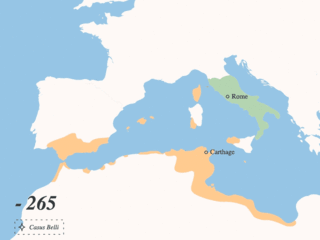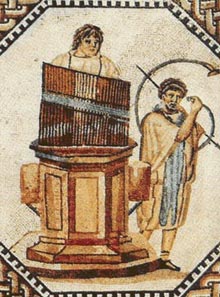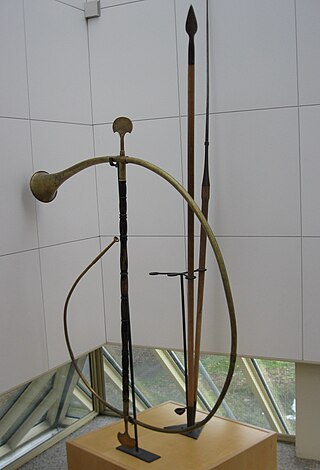
The Punic Wars were a series of wars between 264 and 146 BC fought between the Roman Republic and Ancient Carthage. Three wars took place, on both land and sea, across the western Mediterranean region and involved a total of forty-three years of warfare. The Punic Wars are also considered to include the four-year-long revolt against Carthage which started in 241 BC. Each war involved immense materiel and human losses on both sides.

The Third Punic War was the third and last of the Punic Wars fought between Carthage and Rome. The war was fought entirely within Carthaginian territory, in what is now northern Tunisia. When the Second Punic War ended in 201 BC one of the terms of the peace treaty prohibited Carthage from waging war without Rome's permission. Rome's ally, King Masinissa of Numidia, exploited this to repeatedly raid and seize Carthaginian territory with impunity. In 149 BC Carthage sent an army, under Hasdrubal, against Masinissa, the treaty notwithstanding. The campaign ended in disaster as the Battle of Oroscopa ended with a Carthaginian defeat and the surrender of the Carthaginian army. Anti-Carthaginian factions in Rome used the illicit military action as a pretext to prepare a punitive expedition.
The pilum was a javelin commonly used by the Roman army in ancient times. It was generally about 2 m long overall, consisting of an iron shank about 7 mm (0.28 in) in diameter and 600 mm (24 in) long with a pyramidal head, attached to a wooden shaft by either a socket or a flat tang.

The Salii, Salians, or Salian priests were the "leaping priests" of Mars in ancient Roman religion, supposed to have been introduced by King Numa Pompilius. They were twelve patrician youths dressed as archaic warriors with an embroidered tunic, a breastplate, a short red cloak, a sword, and a spiked headdress called an apex. They were charged with the twelve bronze shields called ancilia, which—like those of the Mycenaeans—resembled a figure eight. One of the shields was said to have fallen from heaven in the reign of King Numa and eleven copies were made to protect the identity of the sacred shield on the advice of the nymph Egeria, consort of Numa, who prophesied that wherever that shield was preserved, the people would be the dominant people of the earth.

The siege of Carthage was the main engagement of the Third Punic War fought between Carthage and Rome. It consisted of the nearly-three-year siege of the Carthaginian capital, Carthage. In 149 BC, a large Roman army landed at Utica in North Africa. The Carthaginians hoped to appease the Romans, but despite the Carthaginians surrendering all of their weapons, the Romans pressed on to besiege the city of Carthage. The Roman campaign suffered repeated setbacks through 149 BC, only alleviated by Scipio Aemilianus, a middle-ranking officer, distinguishing himself several times. A new Roman commander took over in 148 BC, and fared equally badly. At the annual election of Roman magistrates in early 147 BC, the public support for Scipio was so great that the usual age restrictions were lifted to allow him to be appointed commander in Africa.

The onager was a Roman torsion powered siege engine. It is commonly depicted as a catapult with a bowl, bucket, or sling at the end of its throwing arm. The onager was first mentioned in 353 AD by Ammianus Marcellinus, who described onagers as the same as a scorpion. The onager is often confused with the later mangonel, a "traction trebuchet" that replaced torsion powered siege engines in the 6th century AD.

The frumentarii were an ancient Roman military and secret police organization used as an intelligence agency. They began their history as a courier service and developed into an imperial spying agency. Their organization would also carry out assassinations. The frumentarii were headquartered in the Castra Peregrina and were run by the princeps peregrinorum. They were disbanded under the reign of Diocletian due to their poor reputation amongst the populace.

A cornu or cornum was an ancient Roman brass instrument about 3 m (9.8 ft) long in the shape of a letter 'G'. The instrument was braced by a crossbar that stiffened the structure and provided a means of supporting its weight on the player's shoulder. Some specimens survive in the archaeological record, two from the ruins of Pompeii.
The speculatores, also known as the speculatores augusti or the exploratores, were an ancient Roman reconnaissance agency. They were part of the consularis and were used by the Roman military. The speculatores were headquartered in the Castra Peregrina.

The battle of Adys took place in late 256 BC during the First Punic War between a Carthaginian army jointly commanded by Bostar, Hamilcar and Hasdrubal and a Roman army led by Marcus Atilius Regulus. Earlier in the year, the new Roman navy had established naval superiority and used this advantage to invade the Carthaginian homeland, which roughly aligned with modern Tunisia in North Africa. After landing on the Cape Bon Peninsula and conducting a successful campaign, the fleet returned to Sicily, leaving Regulus with 15,500 men to hold the lodgement in Africa over the winter.

The music of ancient Rome was a part of Roman culture from the earliest of times. Songs (carmen) were an integral part of almost every social occasion. The Secular Ode of Horace, for instance, was commissioned by Augustus and performed by a mixed children's choir at the Secular Games in 17 BC. Music was customary at funerals, and the tibia, a woodwind instrument, was played at sacrifices to ward off ill influences. Under the influence of ancient Greek theory, music was thought to reflect the orderliness of the cosmos, and was associated particularly with mathematics and knowledge.

In Ancient Rome the month of March was the traditional start of the campaign season, and the Tubilustrium was a ceremony to make the army fit for war. The ceremony involved sacred trumpets called tubae.

Classical music generally refers to the art music of the Western world, considered to be distinct from Western folk music or popular music traditions. It is sometimes distinguished as Western classical music, as the term "classical music" can also be applied to non-Western art musics. Classical music is often characterized by formality and complexity in its musical form and harmonic organization, particularly with the use of polyphony. Since at least the ninth century it has been primarily a written tradition, spawning a sophisticated notational system, as well as accompanying literature in analytical, critical, historiographical, musicological and philosophical practices. A foundational component of Western culture, classical music is frequently seen from the perspective of individual or groups of composers, whose compositions, personalities and beliefs have fundamentally shaped its history.
The lancea was a javelin used in ancient Rome. According to the Oxford English Dictionary, the word originally came from the Celtiberian language, also cf. λόγχη (lonche), the Greek term for lance. One kind of lancea, possibly known as the lancea pugnatoria or "the fighting lance" was used as a thrusting weapon by cavalrymen. This weapon was used by cavalrymen as it was lighter and easier to use than the pilum. The lancea was also used by auxiliaries. legionaries would use the lancea if the occasion called for it. Arrian equipped his army with the weapon during a battle with the Alans. Soldiers that used it were known as lancearii. It is unclear how the lancea was distinguished from the hastae. Many lancea had amenta, although not all. This kind of javelin also had short wooden shafts and small leaf-shaped metal heads. Sometimes the heads had elongated points which may have been used to increase the penetration of the spear.

The Coolus helmet was a type of ancient Celtic and Roman helmet popular in the 1st century BCE. It was typically made in bronze or brass and, like the Montefortino type with which it co-existed, was a descendant of Celtic helmet types. The explanation of the choice to use bronze can be attributed to the type of warfare that the helmet was used for; also the cultural affinities have influence on why the helmet was made the way that it was. Within a long process of evolution, Roman military armor for the head developed from early pre-Roman helmets. Rome itself had no proper tradition of such objects, as most of the soldiers of the Early Republic made use of helmets produced by the Etruscans, whose craftsmen were known for their ability to make vessels.
The chromatic trumpet of Western tradition is a fairly recent invention, but primitive trumpets of one form or another have been in existence for millennia; some of the predecessors of the modern instrument are now known to date back to the Neolithic era. The earliest of these primordial trumpets were adapted from animal horns and sea shells, and were common throughout Europe, Africa, India and, to a lesser extent, the Middle East. Primitive trumpets eventually found their way to most parts of the globe, though even today indigenous varieties are quite rare in the Americas, the Far East and South-East Asia. Some species of primitive trumpets can still be found in remote places, where they have remained largely untouched by the passage of time.
An aeneator was a specialized player of wind instruments who was attached to a Roman military unit. The word comes from Latin aēneus or ahēneus, "brazen", from aes, "copper alloy". While the size of individual Roman military units may have varied, they made extensive use of both acoustical and visual signaling in communications and each had an assigned banner bearer (vexillarius) and at least one aeneator. A variety of instruments were used by aeneatores, including the buccina, cornu, tuba, and lituus. In addition to their roles in the Roman army, aeneatores were also used for processionals and games, particularly in marching home from war.

Deductions about the music of the ancient Celts of the La Tène period and their Gallo-Roman and Romano-British descendants of Late Antiquity rely primarily on Greek and Roman sources, as well as on archaeological finds and interpretations including the reconstruction of the Celts' ancient instruments. Most of the textual information centers on military conflicts and on maybe the most prominent Celtic instrument of its time, the carnyx.
The Castra Peregrina was a castrum in Rome situated on the Caelian Hill. It was occupied by various military units during the later part of the Roman Empire.

Nafir, also nfīr, plural anfār, Turkish nefir, is a slender shrill-sounding straight natural trumpet with a cylindrical tube and a conical metal bell, producing one or two notes. It was used as a military signaling instrument and as a ceremonial instrument in countries shaped by Islamic culture in North Africa, the Middle East and South Asia. In Ottoman, Persian and Mugulin miniatures, the nafīr is depicted in battle scenes. In Christian culture, it displaced or was played alongside of the curved tuba or horn, as seen in artwork of about the 14th century A.D.

















